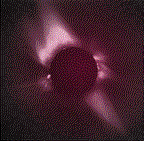 The Institute
of Solar-Terrestrial Physics of the Russian Academy of Sciences (Irkutsk, Russia)
invites solar physicists and astronomy amateurs to observe the total solar eclipse
under the good viewing conditions of early Siberian spring.
The Institute
of Solar-Terrestrial Physics of the Russian Academy of Sciences (Irkutsk, Russia)
invites solar physicists and astronomy amateurs to observe the total solar eclipse
under the good viewing conditions of early Siberian spring.
All required information about the eclipse (as an astronomical phenomenon) and the data to arrange any observation program, is published in Fred Espenak and Jay Anderson, Total Solar Eclipse of 1997 March 9, NASA, Reference Publication 1369, 1995
Information about the anticipated viewing conditions is published in:
V.M.Grigoryev, Sh.P.Darchiya, P.G.Kovadlo, O.A.Ozhogina, "Climatic Criteria to Selection Sites for the Observation of the Total Solar Eclipse of March 9, 1997," Solar Physics, 1996
The path of totality on 1997 March 9 will pass through the territories of five regions of the Russian Federation (Yakut Republic, Khabarovsk Territory, Amur and Chita Region, and Buryat Republic). The eclipse will also be observed in a small section of the northwestern part of China and Mongolia.
Here is the detailed map, 69K.
Since the period of totality for a solar eclipse is only a few minutes, successful carrying out of observations requires knowing the weather conditions precisely at the time of the eclipse. According to generally accepted estimates, currently in Siberia 80-85% of predictions are made only 24 hours in advance. This means that the predicted probability of carrying out of solar observations at the time of the eclipse will be known to us only 24 hours in advance. This greatly constrains the time available for preparatory work, expecially since the experiments for some problems require more time than this just for the installation of equipment. Consequently, the decision as to where the observations should be done must be made ahead of time. For this reason, it is advisable to contact the Irkutsk group - people who analyze meteorological data from many years, estimate the best observing sites, and deal with remote-sensing satellite data of the totality region.
Investigation has shown that the best viewing conditions for the observations will be in the Chita Region, between latitudes 52-53° and longitudes 116-119°.
While certain weather conditions are crucial for carrying out observations, the general climate and comfort conditions at the site are important for successful advance preparation. Despite the fact that March is the first spring month, the first ten days of the month do not differ much from winter in East Siberia. The approach of spring is expressed by the incipient decay of the Siberian anticyclone, which causes some weather instability (weakening of frosts and increase in cloudiness). Based on comfort criteria, i.e., appropriate temperature and wind speeds, the best sites were selected. They are all in the Chita Region, not far from the Trans-Siberian Railway. The latitude range is 49-52° and the longitude range is 112-114°.
Satellite images of the area that includes the path of totality, obtained on 1996 March 5-11 (about one year before the eclipse), showed predominantly clear sky in the Chita Region. Hopefully the same will be true this year, allowing for successful observations.
The Institute of Solar-Terrestrial Physics will be the scientific advising body, while the Joint Stock Company "Irkutsk- Baikal-Intourist" will be responsible for solving any accomodation and transportation problems that foreign observers may experience.
The addresses are:
Dr. V.M.Grigoryev
Institute of Solar-Terrestrial Physics
Siberian Division of the
Russian Academy of Sciences
Irkutsk-33 P.O.Box 4026
664033 Russian Federation
E-mail: root@sitmis.irkutsk.su
JSC "Irkutsk-Baikal-Intourist"
44, Gagarin Blvd., Irkutsk, Av.Mir, Moscow, RUSSIA
664055 Russian Federation Hotel COSMOS, offices 422,423
Tel:(3952)290-270, 290-269 Tel: (095) 217-0422, 217-0423
Telex: 231716 TURNE RU Fax (095) 215-9580
Fax (3952) 277-872, 290-314
9705, Sand Point Way, NE,
Seattle,WA 98115, USA
Tel: (206) 522-5995
Fax: (206) 522-6295